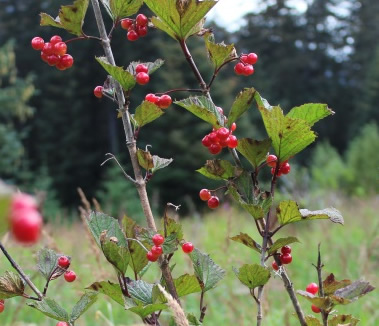Cranberry

Botanical Name: Viburnum edule
Common Name: Cranberry (High-bush)
Other Names: Qalakuak (refers to a person making a face when eating something sour)
Found in: Open coniferous forest, stream banks, meadow edges
Physical Characteristics: High-bush cranberry is usually an upright shrub up to 8 feet tall with smooth branches. Leaves are opposite on the stems, varied in shape, and have very coarse veins. Upper leaves are elliptical while the lower leaves are 3 lobed. All leaves are toothed and turn red to maroon in the fall. The small 5 petaled, white to pinkish flowers are tubular, flare out at the end, and are in clusters above the leaves. The soft, translucent, red to orange berries ripen in August (Pratt 1989).
Nutritional Value: Great source of vitamin B and C and minerals magnesium, calcium, iron, and phosphorus.full of antioxidants.
Parts of the plant used: Berries, Branches/stems for bark/cambium
When plant should be gathered: Berries gathered before frost are higher in pectin and have a fresh aroma. Some prefer harvesting after cold snaps, as chilling sweetens the fruits somewhat. Gather bark from pruned stems in spring or fall.
Plant applications: decoctions, food
Reported Benefits: Colds/Flu, Cough/chest congestion, cuts/scrapes, infections/inflammation, sore throat, urinary problems.
Preparation/Processing: Colds/flu, coughs/chest congestion, sore throat, and urinary problems: Jelly was eaten by itself or mixed into tea or coffee as a treatment for coughs, colds, and sore throats (Port Graham students in Russell 1991). Raw berries were also used for the same purposes and to treat urinary infections (Russell 1991).
Cuts/scrapes, infections/inflammation: The outer bark of the bush was peeled and the cambium shaved. These shavings were then boiled in hot water (for five to ten minutes), placed on a cut, and the entire area wrapped in a bandage. This was helpful in drawing the pus from a cut. Infected wounds were soaked in the water into which the cambium was placed (Port Graham students in Russell 1991). The cambium was used fresh, dried, or frozen and the berries were used fresh or frozen.
Food: Jams and / or jellies, syrups and pies can be made from the berries.
